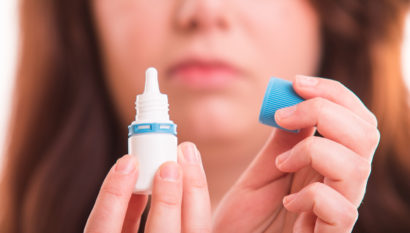Nonsurgical Presbyopia Treatment with Eye Drops
Written by Dr. David Evans Last modified on April 22, 2019
One of our writers at Ceatus Media Group recently started wearing near-vision glasses after experiencing ongoing eye fatigue and difficulty reading his computer screen. He just turned 42, making him a prime candidate for presbyopia, age-related loss of near vision. Even though he’s well educated about the safety and efficacy of presbyopia eye surgery, he feels perfectly comfortable wearing his trendy new Oliver Peoples reading glasses and is in no rush to consider surgical treatments. (But let’s see what he has to say after he loses or breaks a couple pairs of those expensive frames.)
There are a number of surgeries available to treat presbyopia, including monovision LASIK, blended vision LASIK, RLE, multifocal IOLs, accommodating IOLs and corneal inlays. But surgery is not for everyone, especially for patients in their early 40’s during the beginning stages of the condition. Currently the only nonsurgical treatments for presbyopia are eyeglasses and contact lenses. Very exciting research is focused (no pun intended) on new nonsurgical treatments using eye drops.

One of these approaches (PRX-100) is being researched in our backyard in Coronado, CA by Presbyopia Therapies. It involves an eye drop which causes miosis (constriction) of the pupil without the typical accommodative effect. This constriction creates an increased range of focus that allows for improved near vision without sacrificing distance vision. In essence, it mirrors what is referred to as the “pinhole effect,” (a term that deserves its own in depth explanation, but I’ll save that for another post) which allows for light to be focused more centrally on the retina, improving clarity of vision across a range of distances.
PRX-100 drops take effect 30 minutes after application and last upwards of 5 hours. A pilot study based in Tijuana, Mexico involving 20 presbyopic patients, found that they all experienced marked improvement in near vision. The only side effect was a short-term “dimming” of vision, but this issue was less-noticeable the more patients used the drops. (The dimming occurs because as the pupil constricts, less light is allowed in the eye, making things appear dimmer.)
The other approach (EV06) is under investigation across the Atlantic by Novartis in Basel, Switzerland. Although EV06 is also an eye drop, its mode of action is very much different from PRX-100. As we age, the lens of the eye “crosslinks,” essentially meaning that the tissue fibers harden. This hardening impedes the natural accommodation we experience in our youth and can cause age-related blurred vision. EV06 softens the lens by un-crosslinking the collagen fibers to restore accommodation and improve near vision.
A 90-day randomized trial of EV06 documented an average pretreatment near vision of 20/54 for the presbyopic participants. Post-treatment near vision improved to 20/28, a very significant achievement. However researchers are quick to note that this drop is not capable of completely restoring full accommodative power and perfect near vision. In general patients can expect it to be able to turn back the clock 10 years or so, meaning that at age 40, the drop can help soften the lens to its age 30 elasticity levels. So as you get older, returns from treatments like EV06 will diminish. It’s possible that both drops (PRX-100 & EV06) could be used in conjunction, getting the maximum benefit in combatting presbyopia near vision loss.
In addition to serving as a nonsurgical treatment option for presbyopia, researchers believe that these drops could have additional uses across a variety of eye-related concerns, including corneal scarring, complications from refractive surgery and cataracts. They may also aid in retaining a better level of near vision after refractive surgeries like LASIK, PRK and SMILE. (See my blog post article on near vision after LASIK.)
The surgical options for treating presbyopia have been shown to be safe and proven effective in restoring near vision. But the introduction of eye drops like PRX-100 and EV06 have the potential to turn the market on its head. Far more research and study is needed, but the 2 billion presbyopia sufferers worldwide could see a new, revolutionary treatment option in the next few years. Stay tuned.




